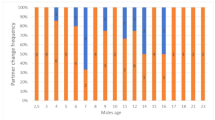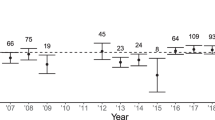Summary
Hypothetical patterns of male and female cumulative reproductive effort in canvasback ducks were used to predict the efforts of males and females in pair-bond reinforcing behavior through a breeding sequence. The predictions were that, at any point in time in a monogamous breeding system, given certain assumptions, (a) the sex investing less should be more active in reinforcing the pair bond, and (b) this relationship should shift within and between breeding attempts with the pattern of cumulative reproductive effort per brood by the male and female. Data on the behavior of newly-formed pairs were obtained by observing apparently paired but unmarked canvasbacks during spring migration. Later, 11 individuallymarked pairs were followed through breeding sequences, including repeated nesting attempts. Observed affiliative behavior fit the predictions reasonably well. That sex whose cumulative reproductive effort was less tended to be more active in maintaining proximity to its mate, initiating bouts of mutual display, and coordinating pair activities. Predictions were met in 14 of 24 cases, results were contrary in 3 cases, and in 7 cases trends were not statistically different (P>0.05). Shifts in relative male and female reinforcement efforts that coincided with major changes in investment were apparent. These results support the proposition that factors other than simple parental investment-related desertion costs might be important to an individual's behavioral ‘decisions’ regarding pairbond reinforcement and ultimately mate abandonment. Discrepancies in a few predicted outcomes further suggest that males and females may use and balance various pair-reinforcement tactics differently through a breeding season.
Similar content being viewed by others
References
Akesson TR, Raveling DG (1982) Behavior associated with seasonal reproduction and long-term monogamy in Canada Geese. Condor 84:188–196
Alexander RD, Borgia G (1979) On the origin and basis of the male-female phenomenon. In: Blum MS, Blum NA (eds) Sexual selection and reproductive competition in insects. Academic Press, New York, pp 417–440
Altmann J (1974) Observational study of behavior: sampling methods. Behaviour 49:227–267
Anderson MG (1984) Social behavior of breeding canvasbacks (Aythya valisineria) male and female strategies of reproduction. PhD thesis, University of Minnesota, Minneapolis, Minnesota
Anderson MG (in press) Variations on monogamy in canvasbacks (Aythya valisineria). Ornithol Monogr
Andersson M, Wiklund CG, Rundgren H (1980) Parental defence of offspring: a model and an example. Anim Behav 28:536–442
Bellrose FC, Scott TG, Hawkins AS, Low JB (1961) Sex ratios and age ratios in North American ducks. Bull Ill Natural Hist Survey 27:391–474
Boucher DH (1977) On wasting parental investment. Am Nat 111:786–788
Buitron DP (1982) Behavior of black-billed magpies during the breeding season. PhD thesis, University of Minnesota, Minneapolis, Minnesota
Butterfield PA (1970) The pair bond in the zebra finch. In: Crook JH (ed) Social behaviour in birds and mammals. Academic Press, New York, pp 249–278
Dawkins R, Carlisle TR (1976) Parental investment, mate desertion and a fallacy. Nature 262:131–132
Doty HA, Trauger DL, Serie JR (in press) Renesting by canvasbacks in southwestern Manitoba. J Wildl Manage
Drent R (1975) Incubation. In: Farner DS, King JR (eds) Avian biology, vol 5. Academic Press, New York, pp 333–420
Emlen ST, Oring LW (1977) Ecology, sexual selection, and the evolution of mating systems. Science 197:215–223
Erickson CJ (1977) Sexual affiliation in animals: pair bonds and reproductive strategies. In: Hutchinson JB (ed) Biological determinants of sexual behavior. Wiley, New York, pp 697–725
Greig-Smith PW (1980) Parental investment and nest defence by stonechats (Saxicola torquata). Anim Behav 28:604–616
Hinde RA, Atkinson S (1970) Assessing the roles of social partners in maintaining mutual proximity, as exemplified by mother-infant relations in rhesus monkeys. Anim Behav 18:169–176
Hochbaum HA (1944) The canvasback on a prairie marsh. Am Wildl Inst, Washington, DC
Imhof MA, Hewett SW, Golesh R (1982) Statpro users manual. Wadsworth, Boston, Mass
Kanwisher JW, Gabrielsen G, Kanwisher N (1981) Free and forced diving in birds. Science 211:717–719
King JR (1974) Seasonal allocation of time and energy resources in birds. In: Paynter RA Jr (ed) Avian energetics. Nuttall Ornithol Club Publ 15:4–70
Kleiman DG (1977a) Monogamy in mammals. Q Rev Biol 52:39–69
Kleiman DG (1977b) Characteristics of reproduction and sociosexual interactions in pairs of lion tamarins (Leontopithecus rosalia) during the reproductive cycle. In: Kleiman DG (ed) The biology and conservation of the Callitrichidae. Smithsonian Institution Press, Washington, DC, pp 181–190
Knowlton N (1979) Reproductive synchrony, parental investment and the evolutionary dynamics of sexual selection. Anim Behav 27:1022–1033
Low BS (1978) Environmental uncertainty and the parental strategies of marsupials and placentals. Am Nat 112:197–213
Lumpkin S (1983) Female manipulation of male avoidance of cuckoldry behavior in the ring dove. In: Waser SK (ed) Social behavior of female vertebrates. Academic Press New York, pp 91–112
Lumpkin S, Kessel K, Zenone PG, Erickson CJ (1982) Proximity between the sexes in ring doves: social bonds or surveillance? Anim Behav 30:506–513
Maynard-Smith J (1977) Parental investment: A prospective analysis. Anim Behav 25:1–9
Owen RB Jr, Reinecke KJ (1979) Bioenergetics of breeding dabbling ducks. In: Bookhout TA (ed) Waterfowl and wetlands—an integrated review. La Crosse, La Crosse, Wis, pp 71–93
Palmer RS (1976) Handbook of North American birds, vol 3. Yale Univ Press, New Haven, Conn
Pianka ER, Parker WS (1975) Age-specific reproductive tactics. Am Nat 109:453–464
Pickwell GV (1968) Energy metabolism in ducks during submergence asphyxia: assessment by direct method. Comp Biochem Physiol 27:455–485
Prange HD, Schmidt-Nielsen K (1970) The metabolic cost of swimming in ducks. J Exp Biol 53:763–777
Pressley PH (1981) Parental effort and the evolution of nestguarding tactics in the threespine stickleback, Gasterosteus aculeatus L. Evolution 35:282–295
Prince HH (1979) Bioenergetics of postbreeding dabbling ducks. In: Bookhout TA (ed) Waterfowl and wetlands—an integrated review. La Crosse, La Crosse, Wis, pp 103–117
Purol DA (1975) Metabolizable energy of cellulose, three natural foods and three diets for mallards. MS thesis, Michigan State University East Lansing, Mich
Radesater T (1974) On the ontogeny of orienting movements in the triumph ceremony in two species of geese (Anser anser, L. and Branta canadensis, L.). Behaviour 50:1–15
Raikow RJ (1973) Locomotor mechanisms in North American ducks. Wilson Bull 85:295–307
Ralls (1977) Sexual dimorphism in mammals: avian models and unanswered questions, Am Nat 111:917–938
Robertson RJ, Biermann GC (1979) Parental investment strategies determined by expected benefits. Z Tierpsychol 50:124–128
Scott DK (1980) Functional aspects of the pair bond in winter in Bewick's Swans (Cygnus columbianus beweckii). Behav Ecol Sociobiol 7:323–327
Sokal RR, Rohlf FJ (1981) Biometry, 2nd edn. Freeman, San Franciso, Calif
Stoudt JH (1982) Habitat use and productivity of canvasbacks in southwestern Manitoba, 1961–1972. US Fish Wildl Serv Spec Sci Rep Wildl 248
Trillmich F (1976) Spatial proximity and mate-specific behaviour in a flock of budgerigars (Melopsittacus undulatus; Aves, Psittacidae). Z Tierpsychol 41:307–331
Trivers RL (1972) Parental investment and sexual selection. In: Campbell B (ed) Sexual selection and the descent of man 1871–1971. Aldine Press, Chicago, Ill, pp 136–179
Walsberg GE (1983) Avian ecological energetics. In: Farner DS, King JR, Parkes KC (eds) Avian biology, vol 7. Academic Press, New York, pp 161–220
Weatherhead PJ (1979) Do savannah sparrows commit the concorde fallacy? Behav Ecol Sociobiol 5:373–381
Weller MW (1967) Courtship of the redhead (Aythya americana). Auk 84:544–559
Wickler W (1973) Ethological analysis of convergent adaptation. Ann NY Acad Sci 223:65–69
Wickler W (1976) The ethological analysis of attachment: sociometric, motivational and sociophysiological aspects. Z Tierpsychol 42:12–28
Williams GC (1966) Adaptation and natural selection. Princeton Univ Press, Princeton, NJ
Wittenberger JF (1979) The evolution of mating systems in birds and mammals. In: Marler P, Vandenbergh JG (eds) Handbook of behavioral neurobiology, vol 3, social behavior and communication. Plenum Press, New York, pp 271–349
Wooley JB Jr, Owen RB Jr (1978) Energy costs of activity and daily energy expenditure in the black duck. J Wildl Manage 42:739–745
Author information
Authors and Affiliations
Rights and permissions
About this article
Cite this article
Anderson, M.G. Parental investment and pair-bond behavior among canvasback ducks (Aythya valisineria, Anatidae). Behav Ecol Sociobiol 15, 81–90 (1984). https://doi.org/10.1007/BF00299373
Received:
Accepted:
Issue Date:
DOI: https://doi.org/10.1007/BF00299373




